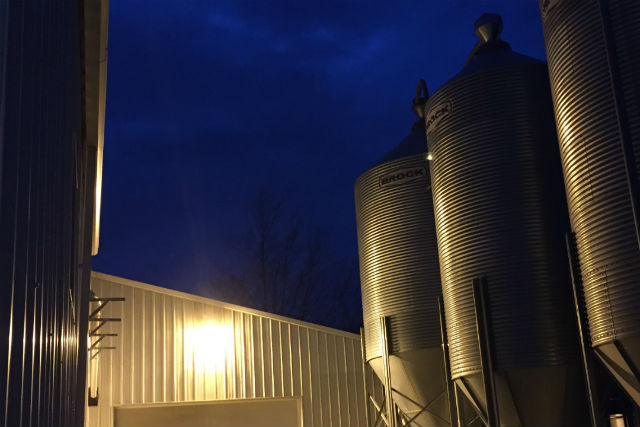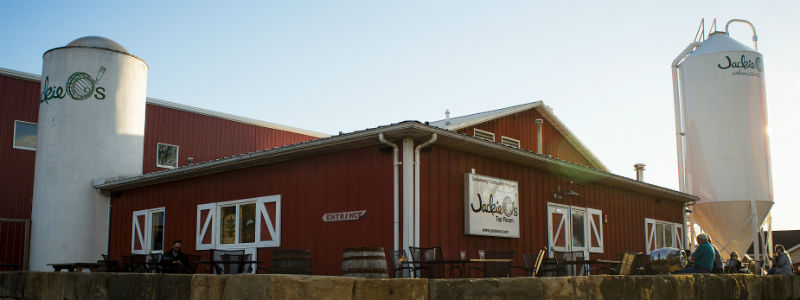
As a brewery grows, so does its need for more malt storage. The days of ordering by the bag, pallet or super sack a month at a time can turn into larger orders that need more room.
Eventually, turning to a silo becomes a great return on investment, usually for breweries that are heading past 10,000 barrels of capacity or are brewing on larger systems — brewhouses of 20-barrels per brew or more.
Dayton, Ohio’s Warped Wing is in that tweener mode right now. The brewery made more than 7,000 barrels in 2016 and after producing 8,000 barrels in 2017 is looking at making 10,500 in 2018, so the plan for a silo is soon.
Co-founder John Haggerty said a grain silo isn’t expected at the current facility because they are looking at having to potentially relocate as they are outgrowing their current space.
“Until we have a better handle on if and when that move is happening I have not been inclined to install the equipment necessary to support a silo,” he said. “However, we expect that ROI to be less than two years based upon the price savings we should be able to achieve on the malt price per pound at current pricing and malt usage rates.”
Jazz Aldrich of Great Basin Brewing in Reno/Sparks, Nevada has been the brewery’s operations manager for more than 15 years. He has overseen many of the storage growths for the brewery. The brewery used warehouse storage for about three years before adding its first silo to house 70,000 pounds at a time.
“ROI on a silo is great,” Aldrick noted. “We pay about 16 cents less per pound and our usual brew length is around 2,000 pounds of bulk base malt. So we save $320 per brew. The silo itself ran about $17,000 so the ROI was roughly 53 brews.”
The ROI on a silo is one of the shortest returns Drew Yeager said he has seen in brewing equipment.
The Brewmaster for Nashville’s Fat Bottom Brewing said that space concerns from the start prompted a conversation to have a silo.
“We just physically didn’t have a place we could place one at our previous location,” he said. “Once we purchased our own land to build on, a silo was probably one of the only things I didn’t have to sway our owner, Ben Bredesen, on.
“For us, the silo paid for itself in six months from the amount we saved per pound. The difficulty is getting use to the cash flow difference from paying $2,000 every week, to $16,000 every silo fill.”
Upland Brewing has three grain silos, one with an 80,000 pound capacity and two with a 40,000 pound capacity said lead Brewer Patrick Lynch.
“The large one has always been designated for our base Pale malt, one of the smaller ones for Pilsen malt, and the third silo has rotated its uses for us,” he said about the Bloomington, Indiana brewery’s setup. That third silo began as a Wheat silo, then was transitioned into a backup Pale silo, and is currently holding locally-malted Vienna malt.
The ability to order in bulk has definitely justified the purchase and installation of these silos, Lynch noted.
“In addition to the cost per pound savings of the malt itself, it requires less labor since we are not manually adding 50 pound bags of up to 2,500 pounds of base malt malt every batch, and we are reducing waste in eliminating the bags themselves,” he said.
The most significant change Upland has made in previous years is ensuring their silos run completely empty every time before they refill them.
“Previously, we had run them low and then topped them off with a new order of malt. This ensured we never ran out of malt prematurely, but made it very difficult to track physical inventories and to isolate individual batches of malt,” Lynch said. “We closely track all incoming COAs for our malt and monitor brewhouse efficiencies accordingly. When we had multiple bulk deliveries blended into one silo, it became impossible to tell which lot of malt was primarily being used in any given brew.”
Running the silos empty before every refill does present several of its own logistical challenges. Lynch said he typically orders a silo refill with about three weeks notice to their suppliers, noting that Upland’s production demands can change on a day-to-day notice
“It is quite challenging to ensure the silo will be empty at the time of filling and that we still have malt on hand for every scheduled brew,” he admitted.
Between August, 2016 and October, 2017, this challenge was eased by having two separate Pale Malt silos at the brewery.
“This is our most used malt and with two silos dedicated to it, we could always ensure an ample inventory,” Lynch said. “In October, 2017, the backup silo was switched to a Vienna silo as we introduced a new year-round beer and closely monitoring the Pale Malt forecasts became more imperative again as we only had one silo dedicated to it once again.”
Lynch said that they are always looking for ways to improve their malt storage.
“One possible upgrade would be to install some infrastructure that would allow us to utilize 2,000 pounds super sacks,” he said. “Currently the brewery either uses 50-55 pound bags or else 40,000-plus pound silos without any middle ground, but he did say that they do have space to add one or two more bulk silos on their grain pad depending on the size.
Aldrick said Great Basin went slightly oversized on its first silo in 2009 so they didn’t have to run it completely empty every time to get a fill.
“We live in a dry climate so no real problems with moisture,” Aldrich said. “The silo itself protects against rain and snow and most of the time whatever moisture we get has evaporated within a couple days. Right now we are using a full silo every couple of months so the malt doesn’t sit around very long.”
Great Basin has an auger from the silo to the mill, which is controlled by a load cell sensor with a relay out. When weight is hit in the grist case, it kills the auger feeding the scale.
Aldrich said Great Basin added another silo to the existing silo in 2014.
“We brew four batches in a single day to fill the 120s and use about 8,000 pounds of malt,” he said. “A silo with around 48,000 pounds — a full truckload — will last six days. With the weather over Donner Pass, we can’t always get a truck scheduled to fill the silo so we had some hiccups where we had empty tanks and couldn’t brew into them because we had no base malt.
“The second silo has alleviated that issue.”
Sometimes, red tape can hold up a silo addition. Ryan Graham, the owner and Brewmaster for Sacramento’s Track 7 Brewing submitted plans for their grain silo to their local land use authority in the early summer of 2017, even as the brewery has worked past 10,000 barrels of production and they still did not have the permit for construction in their hands by the end of the year.
“We have the silo built and sitting on the side of SR-99 somewhere in Modesto waiting for installation,” he told Brewer in December, 2017. “The auger and conveyance system is also ready and waiting.
“We are eager to get the installation complete, as we calculate our ROI at between six and seven months at our current grain usage. The numbers will change as we continue to add fermentation capacity. And that is for all of the construction, including conveyance and foundation/installation.”
So in the meantime, Graham is ordering full trucks of bulk 2-Row every other week.
“We are fortunate that we have sufficient floor space to store our 18 pallets of bagged bulk malt each shipment date,” Graham said. “Yet, the space can — and will certainly need to be — better used for other brewery related purposes.”
Jackie O’s has gone from bags to pallets to trucks over the course of the past five years at their production brewery in Athens, Ohio and they use a silo to house its 2-Row base malt, and that gets replaced every two to three weeks. Art Oestrike, the brewery’s owner said they also have a warehouse that feeds the following weeks grain to the brewery to keep spaces free and clear of too much grain.
“The ROI was about 24 months and (the silo) helps substantially with space and timing,” he noted.
When Cape May moved into its new facility in 2015 they strategically placed its first silo near the back loading area so it could be accessed by trucks for unloading their deliveries.
“We also wanted to put our mill — and other malt storage — just inside from this so the auger coming from the malt silo was as short as possible,” said Cape May Director of Brewing Operations, Jimmy Valm. “Long auger lines can break up the malt before it gets milled, which isn’t good because you want the mill to crush the malt in a manner that you have controlled, not by the auger in random ways.
The New Jersey-based brewery — which started plans on a silo at around 3,800 barrels and is now past 7,000 — still uses just the one silo, although Valm said they have kicked around the idea of installing a second one for easier production needs.
“That way we wouldn’t need to so tightly schedule in when our deliveries arrive,” he said, noting that their silo can hold 60,000 pounds and each delivery is about 48,000 pounds, so the silo needs to be almost empty before they can accept a delivery.
“This would enable us to run out of one silo until it is empty, then just switch over to the other one which would mean we have a wider window for receiving deliveries, but it would also mean we empty out the silos more often and therefore the grain chaff doesn’t build up as much.”
Lynch said that Upland’s grain room is not the easiest to access from their loading dock. When unloading a delivery truck, the pallets of malt travel through three separate garage doors and outdoors across a portion of the brewery’s parking lot.
“When it is raining, we simply cannot stock the grain room or the bags will end up soaked and ruined,” he said. “That being said, I have also seen grain rooms in other breweries that are on different floors, accessible only by stairs, ladders, or pulleys. I am certainly grateful that all of our grain handling can be done by forklift until the moment of milling when we will physically add the bagged malt to the mill.”
Seth Morton, Jackie O’s head brewer also pointed out that working with a silo can change some aspects of a brew day especially in colder climates where temperatures in the winter, like Ohio, can stay below freezing for days at a time. Morton said breweries that are switching over to a silo may have to adjust the mill roller gap when the silo is cold since the grain is more easily pulverized in that state, while also increasing strike temperature due to colder grain going into the mash.




1 Trackback / Pingback